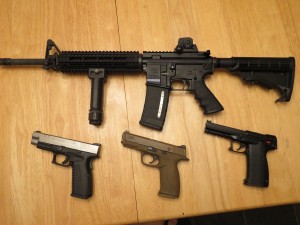Michael Yon does well with his rehearsal of how the Taliban would have pulled off their attack on Camp Bastion, but he does a lot more than that.
In every respect, Southern Afghanistan is a dark part of the world. Without moonlight, most villages are black at night. The brightest places in the country are our bases. Cultural lights present little danger to Taliban moving at night. Our air assets, including our aerostat balloons, are often their biggest concern.
This war is mature. The enemy knows us, and we know them. After 11 years, the Taliban realizes that most helicopter traffic ceases during red illum. Most birds will only fly for urgent MEDEVAC, or for special operations. The enemy closely observes our air traffic. Operations slow under red illum, so air traffic declines, and the chances of being spotted by roving aircraft are reduced.
There is a misconception that UAVs (unmanned aerial vehicles) such as Predators can detect everything. They cannot. Their field of vision is like looking through a toilet paper roll. The UAVs are great for specific targets, such as watching a house, but imagine patrolling. It is like trying to visually swat mosquitoes using no ears, no sense of touch, and only the ability to look through a toilet paper roll. You will get some, and miss many.
We only have enough UAVs to cover small splotches of the country, and there are bases, roads, operations, and targets spread throughout Afghanistan and elsewhere that need watching. The enemy can spoof observers by using a “pattern of life” (POL) for camouflage. So even if our UAV operators see apparently unarmed natives moving, it is no guarantee of early detection.
Our UAVs over Afghanistan fly with their strobes flashing to avoid collisions. If a Predator or Reaper crashes into a commercial airliner because it was flying blacked out while staring at the ground, that is a problem. The enemy can see our UAVs from miles away.
A key realization: the enemy uses cheap night vision gear in the form of cameras that have night functions. When our IR lasers, our IR strobes, our IR illumination or our IR spotlights are radiating, they can easily be seen using cheap digital cameras. I recently told this to some Norwegian soldiers, who were as surprised as our soldiers to learn it. I learned this from the enemy, not from our guys. The Taliban even use smart phone cameras to watch for invisible lasers. The enemy in Afghanistan has been caught using cameras for night vision. It is just a stroke of common sense: I have been doing it for eight years since I noticed an IR laser one night in Iraq.
A Norwegian trooper explained that one dark night in Afghanistan, they got ambushed with accurate but distant machinegun fire. When they turned off their IR strobes, the fire ended. When they turned the IR strobes back on, the fires resumed. When they turned them off for good, it was over.
Many of our people believe that the enemy does not use night vision. There was a time when this was true, but the war has matured and this is now false. If your firefly is strobing on your helmet, or if you are carrying a cracked IR chemlight, do not be surprised if you take accurate fire during a black night. When JTACs mark targets with IR lasers, or when aircraft such as Predators lase for Hellfire shots or for target ID, they look like purple or green sunbeams through night vision optics and they are crazy bright. You cannot miss them.
To maximize chances of success for an assault such as that at Bastion last Friday, the Taliban know that it is best to start early, on a moonless night, just after red illum has begun. Other Afghans engaged in normal masking movements can provide POL camouflage. The enemy knows that only “Terry Taliban” is skulking around after midnight, so they start early when possible.
By 7PM last Friday, the night was very dark, and by 8PM, it was thick and black, making it a perfect time to close in on the target. Camp Bastion would appear lit up like Las Vegas, standing alone, glowing like a giant bubble of light in the “Desert of Death.” On the darkest nights, the lights of Bastion sometimes reflect orange off the clouds above, and they can be seen for miles around, causing Afghans to ask why the base glows like the morning sun, yet they do not have a drop of electricity. The days of goodwill and hope are over.
Go read the rest of Michael’s report. He is at his best, and this is a very good one, with his knowledge of the terrain, the conditions on the ground, and technology on display.
But I want to take off to discuss corollary points. Americans tend to think that every problem is technological, and thus, that every solution must likewise be technologically based. The fact that Marines carry heavy kit means that loads must be lightened so that females can be in the infantry, and thus we send massive amounts of money to DARPA to design ridiculous robotic assistance for troopers.
Mules to carry supplies for the Marines are animals rather than technology, and so DARPA builds ridiculous things like the big dog, which uses an incredible amount of electricity and sounds like a million Africanized bees. The Air Force must proceed apace to pilot-less aircraft since everyone knows about UAVs now, and finding IEDs requires sophisticated sensors rather than dogs.
But in reality, with their expeditionary mission, the Marine infantry will always carry heavy kit, and DARPA cannot and should not negate the differences between men and women. Robots on the battlefield are a very large set of failure modes waiting to be actualized, animals will always be needed in war, and there will always be pilots in the Air Force. And … solving the problem of IEDs means killing the IED-makers.
Sometimes technology can make things better for us, but just for a period of time. Sometimes it can be our enemy, and reliance on it can make us incapable of making war without it. As for failures, I am an engineer by training and trade, and I can outline failure modes (from which you cannot recover) until you can’t listen any more.
The Taliban have learned our habits, our vulnerabilities, and practices – good and bad – and have mentally processed our methods. As my friend John Bernard said recently, concerning making war, we are trained to turn the enemy on his heels and then capitalize on that by not allowing him to regain his balance. But we didn’t do that in Afghanistan.
Rather than kill the enemy, our mission is now to protect the population in a tip of the hat to state-building and population-centric counterinsurgency. That mission has worn thin, and we are even now watching ISAF command jettison the very doctrines that we brought to the campaign.
If I thought we would resource and retool the mission, I would be the first to say stay. But we won’t, and the mission is over. Oh, we will be back. We will endure Afghanistan / Pakistan / Hindu Kush II, and maybe III. Perhaps then we will have the heart necessary to win the campaign.
But as Michael and I have both written, it’s time to come home. The Taliban have our number, and the very troops we have put in place to prevent their return are killing U.S. servicemen.






